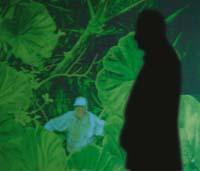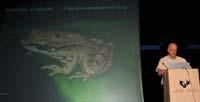2007/01/01
227. zenbakia

eu es fr en cat gl
Aparecerá un contenido traducido automáticamente. ¿Deseas continuar?
Un contenu traduit automatiquement apparaîtra. Voulez-vous continuer?
An automatically translated content item will be displayed. Do you want to continue?
Apareixerà un contingut traduït automàticament. Vols continuar?
Aparecerá un contido traducido automaticamente. ¿Desexas continuar?
Sioux, magic and frogs
Text created by automatic translator Elia and has not been subsequently revised by translators.
Elia Elhuyar
The ear sticks to the ground, stays, rises, raises the arm to the height of the chest and, with the index very stretched, a long hair says "from afar" short and cold. That's for me an Indian sioux. The safest thing is the invention of one of the Hollywood filmists, I already know. But is it possible to communicate something from the earth?
Sioux, magic and frogs
01/01/2007 | Txintxurreta Agirre, Arantxa | Elhuyar Zientzia Komunikazioa

(Photo: A. A. Txintxurreta)
They are able to feel the vibrations thanks to the pulse of the inner ear. And if someone comes into contact with the floor, they will discover it soon. Just as you approach silently, they will notice you. In fact, one of its modes of communication is the seismic movements that occur with the earth. They are frogs, not sioux.
However, the most common way to communicate frogs is similar to what we use: by waves that are transmitted through the air. They use the frequencies we hear... in most cases.
And they have recently discovered frogs capable of communicating in ultrasound. The ancient amphibians who were trapped between water and earth are still surprised.
A possible film
Summer 2000 China. The light of the Moon barely illuminates the rocks, so closed is the forest. At the head of the lanterns, a group of people advance on the road. These men have not attracted the beauties of the environment, but have been attracted by a small brown animal called Amolops tormotus. To record their singing they are introduced in the jungle with all the instrumental. But no choir is heard despite the frog. Desperate. The sound of water is heard - the noise is so loud - and the needles of the forest beasts; there are also songs of some birds. No ranges.
The beasts slowly calm down. The night advances. The beasts are silent, but it is curious that the birds are not silent. Men are bored. In the absence of frogs, they begin to look at the trees in search of those birds. Surprise. That noise comes not from the trees, but from the earth! They are frogs and is also Amolops tormotus!
They start recording. His singing is surprising: it is very varied and seems to reach the ultrasound. But it is not possible, biology books say that amphibians are not able to do so.
Two years later the human team returns to the same place. On this occasion he accompanied the German Hans-Ulrich Schnitzler. Expert in ultrasound recording, he works mainly with bats. How did they convince him to go to China? This is what one of the men told me: "I asked him: instead of placing the microphone upwards, can you direct it to the ground? He answered me that yes. Then I said to him: Do you want to come to China? He answered me: yes, because I have never been."
And he confirmed the suspicion that these frogs can run on ultrasound and very high frequencies, to see if the Schnitzler apparatus is not able to measure the high frequencies of this subject!
A subsequent expedition (2005) showed that, in addition to singing in very high frequencies, these frequencies were communicated, that is, they were not simple noises, which were made in ultrasound: when expanding the engraving with a speaker, the frogs responded.
Rana Txan

(Photo: A. A. Txintxurreta)
I call her frog Txan. Amolops tormotus in Latin, and aguhar ahur in Basque (not txan-txa). But I call it the frog Txan: on the one hand, because it is from China, and it seems that one of the most common surnames in China is Txan, as if it were Agirre (by the way my second surname); on the other, because it has something of a magician; if not, how does a frog to think it is a bird? And how does it get other frogs to hear when we hear nothing?
Most frogs run the tone up and down the tone. But the frog Txan rises and lowers the tones to your taste and, therefore, gives the cheerful song of a bird (forgive the magicians for saying the secret! ). To run has two pairs of mouth sacks, a pair under the mouth, and another pair on the sides. Thanks to them, you can make melodies with many harmonies. This is common in mammals and birds, but in frogs it was not known, so the mixture was understandable.
What has been described so far, that is, those corros that are something between Montserrat Caballé and the chorizos, do them in frequencies that you and I listen, but sometimes it makes the run disappear, or at least that is what we think: running at high frequencies, it emits sounds that escape the ear of the man, that is, they disappear from our ears.
This frog has special ears to catch these sounds: unlike the rest of the frogs, it has an inner eardrum and is extremely thin. It is transparent, it is so thin. Following this tympanum they arrived in China, as the man who was heading further back recognized: "We knew they had a special eardrum and went to China looking for why."
Similarities between similarities and similarities
With regard to communication, the difficulty of resembling frogs has been detected, since the different forms of communication, both seismic and ultrasound, allow to use large frequency intervals of sound.
Regardless of whether or not Sioux used the land to communicate, they lived well adapted to the environment, such as these frogs. However, they encouraged them to live in reserves. Subsequently, failing to comply with the agreement, General Carter entered Indian lands. Sioux died a lot. That's not what the Hollywood rodero invented. We hope that in that frogs do not resemble the Indians!
-
SOUND is any variation of the air pressure detectable by the ears. Everything that vibrates. It is transmitted by air. The number of pressure variations in a second is called frequency and is measured in hertz. An adult man can hear between 20 and 20,000 Hz.
Sounds of more than 20,000 hertz are called ULTRASOINU. Bats and dolphins use them to communicate and know where they are and what they are around (ecoloquio). They are also used by grasshoppers and crickets. The man, for his part, uses to make ultrasound, to cure sprains, to clean precious stones, etc.
The EAR receives the sound and crosses the eardrum to reach the middle ear and from there to the inner ear. There the sound becomes a nervous impulse that is sent to the brain. The eardrum of A. tormotus is protected at the end of an auditory tube. Most frogs have the eardrum on the outside and do not need the tube.
Questionnaire to the protagonist
Neither the Sioux nor the Txan ranita; we have made the questionnaire to Dr. Peter Narins, of the group of researchers who traveled to China, who invited Hans-Ulrich Schnitzler to travel to China. Prestigious researcher, he studied electrical engineering at the University of Cornell (USA), is a doctor in Neurobiology and Behavior. He is a teacher and amateur, plays various musical instruments. Communication and sounds are his passion and communicates with passion everything he knows. He attended the first congress of herpetology of Euskal Herria, organized by the Sociedad de Ciencias Aranzadi in October.
Why is it interesting to investigate a small frog that lives in China?
The money for this research is provided by the head of NAGE (US health organization). And they asked him: Why do you pay money to do research like this? And he answered: the way animals communicate can help to understand our way of communicating. In addition, there is another thing. I have been working with a friend who has just finished a project for 25 years: he has created a hearing aid for man. It is better than any other hearing aid. It is very directional. For example, if the hearing aid is on a party full of people and someone speaks live, the hearing aid is able to receive what that person says and reject the rest of sounds. They will take you to the market within a couple of years. For people who do not listen well, it will be an excellent improvement. Frogs have developed the apparatus by studying how the sounds are located. The ability of amolops to know where sounds come from is enormous. We are interested in the mechanism used for this.
Amphibians are now able to communicate in ultrasounds. What does that mean?

Peters Narins at the congress of herpetology.
(Photo: A. A. Txintxurreta)
If Rana has chosen this strategy, it means that perhaps more animals have chosen the same way. And we have already found in China a bird that communicates in ultrasound. And at the turn of China, the friends of Germany and us, each in their villages, begin to record the birds and common animals of the area. And we have found that several birds and frogs are able to communicate in ultrasound. Why don't we find it before? Because it never occurred to us to investigate. Therefore, outside the limits of our senses, there is a very interesting world. It is important to know how communications between animals and between us evolved.
Why do you use ultrasound?
The waterfalls of the Tau Hua Creek are very noisy and more intense after the rains. Sometimes we had to shout to speak together. It can be thought that ultrasounds are used to avoid this noise. We know that in the same habitat there are more animals that communicate in ultrasound – bats, insects – but we know that in that same habitat it is not communicated in ultrasounds. That is, there are various ways to combat environmental noise. Some species have chosen to increase frequency and others have not. There is no single solution.
The strap is made by the males. What do you know about the female of Amolops?
We still do not know anything about females. We have seen them and do not have the kind of ear that the males have. But we have to continue working to know more. That is why this year we will return to China, which will be the fifth time.
Sounds on the Internet
In Madrid is one of the most important Fonotecs in Europe ( www.fonozooo.com ). In this library there are Vivaldi, Queen or Laboa. There are birds, mammals, insects, fish and, above all, amphibians. Biologist Rafael Márquez is responsible for collecting, collecting and storing his sounds.
Does your way of working influence the discovery of a frog that communicates in ultrasound?
This discovery is a break and a challenge of the established norms and everything learned. In practice it will not change the way we work, since 99% of species produce sounds within our hearing capacity. However, in places similar to the habitat of this frog, ultrasound material should be used. It is a more expensive material, more limited and difficult to use.

Rafael Márquez, biologist, head of the library of Madrid.
(Photo: A. A. Txintxurreta)
Who wants to hear the animals in the collection?
In principle, the scientific collection is aimed at the scientific user. Most use them to identify species. For many species, the song is like their signature; the females listen and decide whether it is their species or not.
More and more scientists use the collection to perform animal follow-ups. If the existing singing is known in a natural environment, an acoustic inventory of it can be made. It is a much cheaper and less aggressive inventory than that based on hunting or inspections. Pure recording brings a lot of information.
In addition, there is a more commercial market, the media. The collection is not aimed at them, but also performing atmospheres based on sounds.
Txintxurreta Agirre, Arantxa
Services Services Services
227 227
2007 2007 2007 2007 2007
1.
035 035 035
Biology Biology Biology
Article Article Article
Services Services Services









